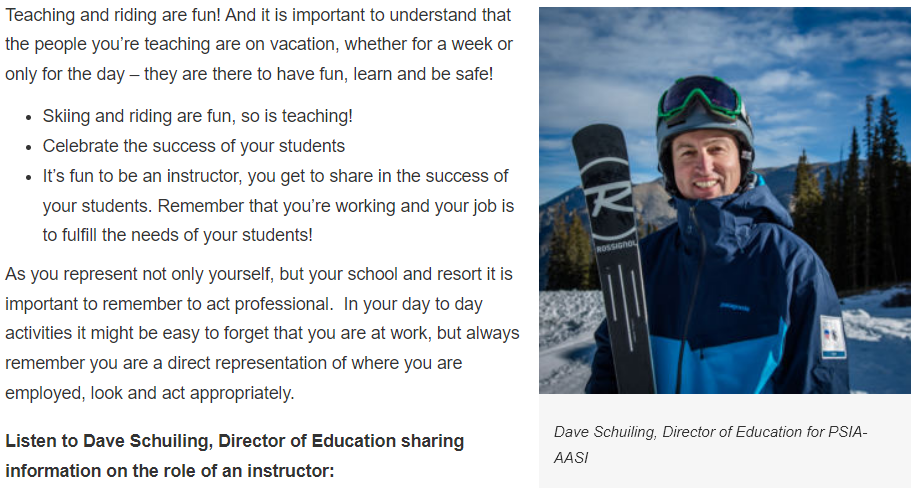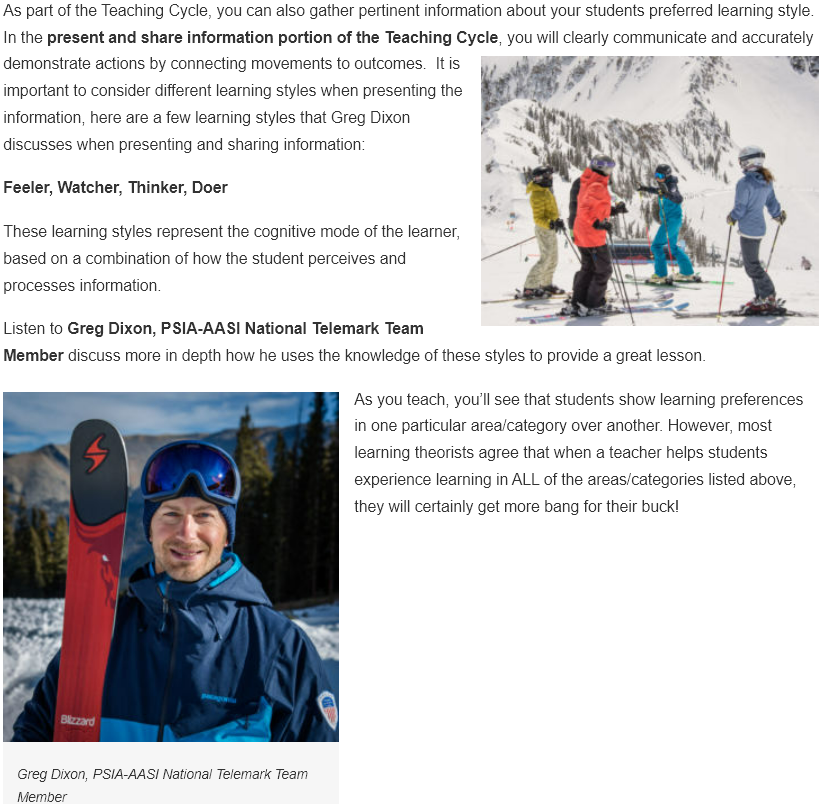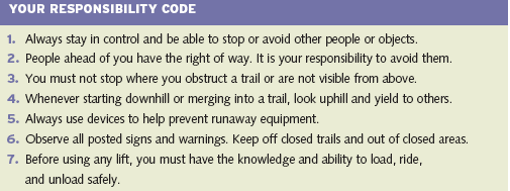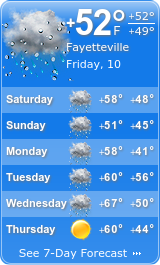PSIA-AASI Online Course : New Instructors
Best Ways to Teach Guests to Ski & Snowboard
•Welcome to the exciting world of teaching snowsports, where you get to share your love of sliding on snow with others making sliding that much more rewarding!
•You ski or ride because you find great joy on the mountain, your job as an instructor is to pass on this passion and help others learn to slide while keeping them safe in the mountain environment – so what can you expect as a new instructor?
Video:
•https://www.youtube.com/watch?v=OEYuQ3Mx5bM&t=5s&ab_channel=PSIA-AASI
SAFETY: The first value, safety, reminds you to be safe on the mountain in order to prevent injuries to yourself, your students, and other resort guests. As an instructor, you are a professional held to a high standard of conduct on the mountain. By continually identifying and addressing potential safety concerns, you are showing your students that you care about their security and well-being.
FUN: In this context, fun can mean playfulness, but more importantly, it means making sure that the experience offers all participants the appropriate amount of challenge, some degree of meaning that creates a connection and personally rewarding achievement.
LEARNING: People take lessons for a variety of reasons, maybe to improve performance, learn a new trick or increase understanding of the sport. Having the ability to facilitate a supportive and collaborative environment that fosters learning and meets individual student needs is crucial for the success of our industry.
•As an instructor you have the opportunity to introduce guests to all kinds of ways to slide on snow, there are many ways to enjoy the mountain environment. Our goal as instructors is to support guests while they are on their adventures through creating safe and fun educational environments. As you become more familiar with your sport of choice you may find additional educational opportunities can expand your knowledge as a teacher. Not just by focusing on a specific discipline but through alternative specialist fields like freestyle and children’s specific focuses.
•At PSIA-AASI we offer certifications and specialists in several areas, these include:
•Alpine Skiing
•Adaptive Skiing and Snowboarding
•Cross Country Skiing
•Telemark Skiing
•Snowboarding
•Specialists:
•Freestyle
•Children’s
•When you attend training for new instructors, you will learn how the school operates and what you need to know to be an employee of the school. Safety training is also an important aspect to teaching snowsports, it is essential to understand safety training when teaching others how to slide.
•Guests of all types and ages come to snowsports areas to enjoy the winter environment and to learn how to slide on snow. You will be teaching students with a wide range of skills from beginners who have never been on snow to advanced students.
•Beginners are especially important to the world of snowsports, if they have a great time and enjoy their experience they are more likely to continue to advance their skills on snow; thus increasing the passion for the sport and maybe even bring others to enjoy in the fun.
•Instructors also teach students of all age ranges, from children to adults.
•Your school will provide you the tools and knowledge to be successful as an instructor
•Training includes how to teach and what to teach – Teaching Cycle
•Safety training – expect to learn about the safety aspects of teaching in your specific ski or snowboarding area
•Part of being an instructor is to maintain a professional appearance and attitude, be sure to ask questions if you don’t understand what is expected of you and always be open to learn more!
•Throughout your training, you must always remember to look and act professionally, not only when you are on the hill but anytime you have a uniform on!
Learning Partnership
•As an instructor you will continue to utilize the guest services information to build a stronger relationship with your student. Essential to the success of your student/instructor relationship is the instructor’s understanding of the student’s needs and expectations as well as the student’s willingness to actively participate in learning. As part of the teaching model (which will be explained in the second course of this series) the Learning Partnership is the rapport an instructor forms with the student.
•This partnership fosters a student-centered lesson in a learning environment that is experiential and supportive. By establishing engaging, motivating and interactive relationships with your students you are better able to measure the impact of learning and adjust your lesson throughout your time together as needed.
Learning Partnership (Student Profile)
•This aspect of the Learning Partnership identifies the non-technical factors each student brings to the learning environment. Although these factors do not change snowboarding mechanics, they may influence the skill development and body movements that become a lesson’s focus.
•Here are the components of the student makeup:
•Personal characteristics and background
•Past experiences
•Attitudes and emotional states
•Learning styles and preferences
•Motivations and goals
•Identity, beliefs, and personal values
•Physical conditioning and health
•Expectations and understanding
•Social factors
Learning Partnership (Instructor Profile)
•As there are characteristics that make each student unique, certain characteristics make each instructor unique. In the same way the student profile identifies the nature of your students’ attitudes and actions, your own personal background, values and beliefs, goals and motivations, physical conditioning, etc., contribute to your abilities and behaviors as a teacher. As a practice of self-awareness, you should be comfortable identifying these factors as they apply to you. In addition to these personal traits, you also bring a unique skillset as a teacher, leader, and facilitator. Your instructor profile influences your interactions with your students and defines your contribution to the Learning Partnership.
•Here are the components of the instructor profile:
•Sport-scientific knowledge and performance
•Teaching experience and understanding of learning theory
•Resort and snowsports school knowledge
•Preferred social style
•At a resort or any snowsport area, the ski or snowboard instructor often spends the most time in direct contact with students and the general public. Because of this, instructors often influence students in many respects, sometimes unintentionally. In order to earn and maintain the respect and confidence of our guests and from our co-workers, instructors need to maintain the highest degree professionalism.
•Some common aspects of professionalism for instructors include:
•Being on time to your assigned location
•Having a clean tidy uniform
•Treating guests and fellow employees with respect
•Greeting guests in a friendly positive way
•By choosing to accept all tasks with a positive “can do” attitude you demonstrate that you are a positive leader within your ski and snowboard school. This will increase your professionalism and provide you with the capabilities to have a great career within snowsports.
•PSIA-AASI Board Chair Ed Younglove offers words of wisdom for new and future instructors – including the value of interacting with more experienced colleagues and taking advantage of PSIA-AASI’s education tools.
Module 2: Working With Students
Intro.
•During this lesson you will learn about the elements of the Learning Partnership and how they are related, as well as the Teaching Cycle and how it helps you to better understand your students, develop strategies for teaching them and how to structure and conduct a lesson. You will also work through student learning styles and ways in which to create a safe, fun and positive learning environment.
•Remember in module one, we introduced the Learning Partnership. In this module we will dive deeper into the Learning Partnership as well as the Teaching/Learning Cycle. Essential to the success of this relationship is the instructors understanding of the students needs and expectations and the students willingness to actively participate in the learning. In the end the Learning Partnership allows us as instructors to improve our soft skills and shape the lesson to the students needs.
Introduction to the Teaching/Learning Cycle
•As one of the fundamental tenets of PSIA-AASI’s approach to instruction, the Teaching/Learning Cycle, provides a blueprint for working with students to create engaging, fun, and effective learning. The Teaching/Learning Cycle serves as a guide to formulate an appropriate lesson plan and adjust the technical direction as needed throughout the lesson.
•For simplicity’s sake, newer instructors can consider the Teaching/Learning Cycle as a series of steps. This approach creates an orderly flow to the lesson, reducing the decision-making process for newer instructors.
•Rob Sogard explains how the Teaching/Learning Cycle works, and how you can use it to create the best beginner experience.
•https://www.youtube.com/watch?v=ttiYdCWXbD0&ab_channel=PSIA-AASI
Keep it Safe
Your Responsibility Code
•As a snowsports instructor, your first duty is to your student’s safety, you must keep yourself and your student safe on the mountain in order to prevent injuries to yourself, student or other resort guests. The safety of your student and guests must remain the primary concern of every instructor in using “Your Responsibility Code” and other safety guidelines within your resort or school.
Helmet Safety
•As part of keeping it safe on the hill, PSIA-AASI recommends the use of snow sports helmets; helmets can make a difference in reducing or preventing injury from falls or other impacts. At the beginning of every lesson, be sure your student’s helmet is properly fitted; it should not be too small or too large. A properly fitted helmet should be snug, and not obscure vision or affect hearing. A helmet that does not fit correctly may not perform to its ability in the event of an accident. If your student does not have a properly fitted helmet, you can always take them back to the rental shop to ensure they have the proper sized helmet.
Lift Safety Guidelines
•As it is your responsibility to adhere to your resorts lift policies, below we have a few guidelines to help you along the way. As you work through the Teaching Cycle and assess the student, it is important to determine whether your student knows how to ride a lift. Students should be taught how to safely load, unload and ride a lift. You should never assume they know how to load, but instead walk them through the process.
•GET ON
•As a chair passes you at the “Wait Here” sign, move ahead quickly to the “Load Here” sign and line up evenly. When the next chair comes behind you, sit on the seat, and slide back as far as you can – to keep from falling off the chair.
•SIT BACK, SIT STILL, HOLD ON
•Sit way back to keep from falling from the chair and enjoy the ride to the top! No horsing around, it’s dangerous when you are riding up in the air.
•AT THE TOP, PLAN AHEAD TO UNLOAD
•At the “Unload Here” sign it is time to get off. Stand up, and ski down the ramp. Watch for others ahead and ski around them. Move out of the way quickly, so others can unload too.
•It’s YOUR Responsibility to know how to use and ride the lift safely.
•Need assistance? Ask the lift attendant for help. The smallest kids should load closest to the attendant.
•Remove & carry packs. Do not use phones, music or games while loading or unloading.
•It is OK to miss a chair and wait for the next one.
•When loading, watch for approaching chair and then sit to the back once seated!
•Drop something? Let it FALL. Any item dropped can be picked up later.
•Absolutely NO horseplay on the lifts!!
Trail Markings
•Before you ride a lift during your first few days, make sure you can handle the trails at the top. Check your trail map and make sure the trail symbols served by the lift fit your ability. If you have any questions or need directions, go talk to a lift attendant or anyone in a resort uniform.
•Here’s what the signs of the slopes mean:
•Green Circle: Easier
Blue Square: More Difficult
Black Diamond: Most Difficult
Double-Black Diamond: Most Difficult, use extra caution
Orange Oval: Freestyle Terrain.
•You’ll find run designations on trail maps and posted on mountain signs. The same trail symbols are used at every resort in the country, but as Albert Einstein must have said, “It’s all relative.” A Green Circle trail at one resort might not be as tough at a different resort. Not a big deal. The trail ratings are consistent within each resort. So all the “Greens” at a ski area will be about the same difficulty, as will the “Blues” and the “Blacks.”
Terrain, Conditions & Weather
•Skiing and riding is a wonderful way to enjoy the great outdoors, while you are out on the slopes it is important to remember that you are outside in the elements. As you work through your lesson with your students, keep in mind some of the variables that could change with terrain, conditions and weather. Keep an eye out for behavior changes in the student that are potentially out of character, be aware of the conditions and terrain that might effect your student
Terrain
•Terrain selection can enhance or inhibit success. Use the proper terrain for the level and the ability of the guests in your class as well as the technique being taught. Instructors and guests should realize that going to terrain that is too advanced too quickly can create defensive habits which will be hard to eliminate later. The age-old instructor adage goes, “Teach new skills on old terrain, and practice old skills on new terrain.” You should be familiar with the terrain prior to the lesson, as well as the effect changing conditions can have on difficulty. Also remember it is wiser to expose a student to something new when they are fresh, not necessarily at the end of the lesson as fatigue sets in.
Cold Weather
•Students are not always aware of the effect extreme weather can have, cold weather can affect guests both psychologically and physically. On cold days, try to keep the class moving and keep stops brief. If you are going to stop for prolonged periods of time, look for areas out of the wind and away from blowing snow. Whenever possible, keep the guests’ back to the sun or wind for added warmth, facing away from the sun also allows the student to see you better, especially if you are talking to them. As you are leading the group look for signs of fatigue or inability to focus in the students, as this can indicate hypothermia, heat exhaustion or dehydration.
Sun & Wind Exposure
•Exposure to wind, sun and cold is a big deal. When at altitude the sun’s rays are more intense and being surrounded by snow reflects the sun’s rays even more. Remember to apply sunscreen multiple times per day, which will help decrease the chances of getting a sun burn. The application of sunscreen also help moisturize skin that can become dry due wind. High wind exposure can also create an apparent temperature difference called “wind chill”. Wind chill can increase the chances of frost bite on skin that is exposed cheeks, noses, chins and ears are more susceptible to frost bite. Help your students understand and prepare for the elements by sharing this information.
#RideAnotherDay
•To help ensure that students have a good time on the hill and feel comfortable trying new things, your number one priority as an instructor is to provide a safe learning environment by, among other things, evaluating terrain, traffic, and snow conditions. Beyond that, it’s vitally important than instructors teach all students about safety, especially children and other beginners for whom safety awareness has far-reaching effects as they progress.
•When it comes to safety, you have no greater champions than Chauncy and Kelli Johnson, whose poignant story is told in the video below. Their love for skiing and riding, and their dedication to sharing their story with others in the hope that it will help more people think about their surroundings while enjoying the mountain experience. In this video below, Chauncy and Kelli shared why creating the #RideAnotherDay campaign is so important to them and their family.
•1. Be Ready
•Be ready to slow down or avoid objects or other people at any time.
•2. Stay Alert
•Stay alert to what’s going on around you, especially other skiers and riders.
•3. Plan Ahead
•Ease up at blind spots, check uphill when merging onto trails, and give other skiers plenty of room when passing. Look out for spots on the run where traffic merges or you can’t see what’s coming next.
•By doing these three things every run, you’ll be helping keep the slopes safe and enjoyable, for you and everyone else.













